Verona is a city in northern Italy. The city of Verona was founded by the Romans in the first century BC. In the 6th century, the Ostrogothic King Theodoric had his favourite residences in Verona, Pavia and Ravenna. Verona flourished under the rule of the noble family of the Scaliger in the 13th and 14th centuries and under the rule of Venice from the 15th-18th centuries. The city of Verona was under the control of Austria until 1866. Verona became part of Italy in 1866. Verona has a number of monuments from the Roman Empire, among them an amphitheatre and a Roman city gate. The amphitheatre of Verona is the third largest Roman amphitheatre in the world, after the Colosseum in Rome and amphitheatre in Capua. In the city of Verona are also monuments from the medieval and the Renaissance. Verona was a military stronghold. Castelvecchio, the Old Castle, and the fortified Castelvecchio Bridge are splendid examples of military architecture. Although Romeo and Juliet were fictional persons, in Verona is a house said to be Juliet's house. Juliet's House in Verona is a place of pilgrimage for lovers. The city of Verona gained the status as a UNESCO World Heritage in 2000.
www.werelderfgoedfotos.nl © Copyright World Heritage Photos
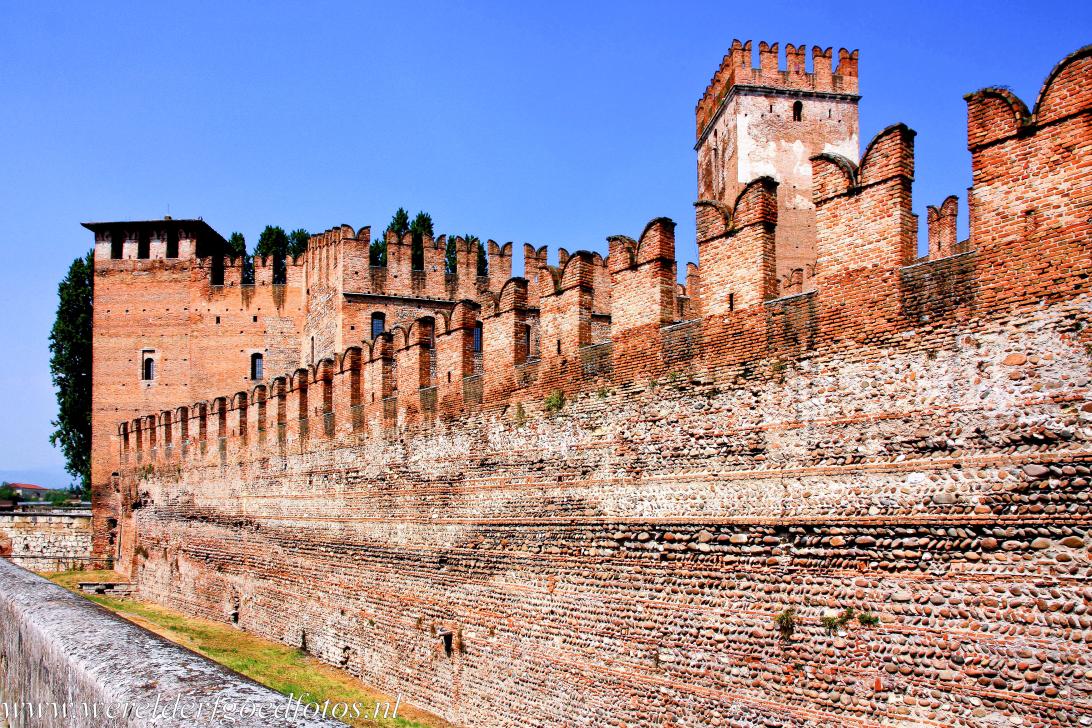
City of Verona: Verona flourished under the rule of the noble family of the Scaliger in the 13th and 14th centuries. The Castelvecchio Castle was built in the period 1354-1357 by the Scaliger family. It was a home and defensive fortification. Nowadays, the Castelvecchio Castle houses a museum: Museo Civico di Castelvecchio.

City of Verona: Verona flourished under the rule of the noble family of the Scaliger in the 13th and 14th centuries. The Castelvecchio Castle was built in the period 1354-1357 by the Scaliger family. It was a home and defensive fortification. Nowadays, the Castelvecchio Castle houses a museum: Museo Civico di Castelvecchio.
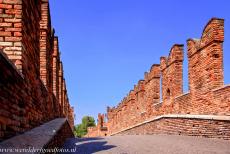
City of Verona: The Castelvecchio Bridge is a 120 metres long fortified bridge. The Castelvecchio Bridge is also known as the Ponte Scaligero, the bridge was built in 1354-1356. At the time of its completion, the Ponte Scaligero had the largest bridge span in the world. The bridge is almost 50 metres long. The Ponte Scaligero spans the Adige River.
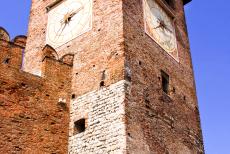
City of Verona: The clock tower of Castelvecchio Castle, the clock was added in the 19th century. The Castelvecchio is situated on the banks of the Adige River, the castle is surrounded by walls, defensive towers and a moat, once filled with waters from the Adige River. The castle was built of red brick and is a medieval architectural masterpiece.
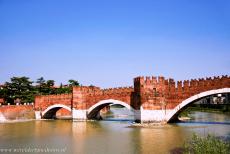
City of Verona: The Castelvecchio Bridge or Ponte Scaligero crossing the Adige River. In 1945, the Castelvecchio Bridge was completely destroyed by the retreating German army. After WWII, the reconstruction of the bridge started in 1949 and was completed in 1951. The city of Verona was inscribed on the UNESCO World Heritage List in 2000.
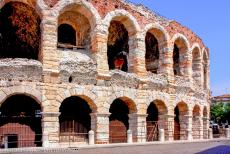
City of Verona: The amphitheatre of Verona or the Verona Arena was completed in 30 AD. The amphitheatre of Verona could accommodate 30000 spectators and had four main entrances. The façcade of the amphitheatre was built in large blocks of pink and white limestone. It is one of the best preserved ancient structures of its kind.
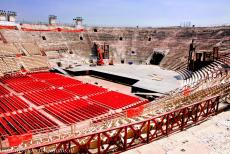
City of Verona: For almost 400 years, the amphitheatre of Verona was used for gladiator fights and animal contests. Nowadays, the amphitheatre is renowned for the spectacular productions of operas because it has stunning acoustics, the amphitheatre of Verona is, after the Colosseum in Rome and the amphitheatre in Capua, the third largest Roman amphitheatre in the world.
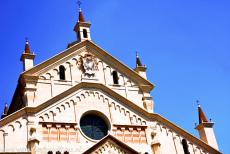
City of Verona: The Verona Cathedral was built after two churches on the same site had been destroyed by an earthquake in 1117. The Verona Cathedral was built in the Romanesque style. The cathedral was consecrated in 1187. The bell tower of the cathedral was left unfinished. The interior of Verona Cathedral dates from the 15th century.
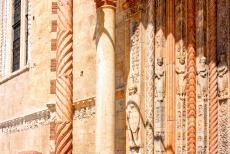
City of Verona: The porch of Verona Cathedral, the Santa Maria Matricolare, is supported by two griffons. The statues of the portal depict Biblical prophets. On either side of the portal are the jamb statues of the holy warriors Roland and Oliver. The city of Verona was declared a UNESCO World Heritage in 2000.
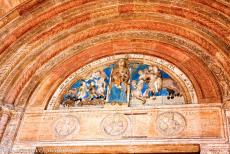
City of Verona: The official name of the Verona Cathedral is the Santa Maria Matricolare. The tympanum above the main portal depicts the Virgin and Christ the Child, surrounded by the Adoration of the Magi and the Annunciation to the shepherds. On the lintel are the symbols of hope, faith and love.
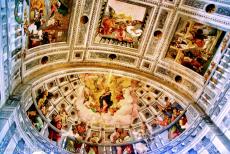
City of Verona: The decorated barrel vault of the Cappella Maggiore, the main chapel of Verona Cathedral, Santa Maria Matricolare. The chapel was designed by the Venetian architect Michele Sanmicheli, the frescoes were made by the Renaissance painter Francesco Torbido in 1534. The present neo-Gothic interior of the cathedral dates from the 15th century.
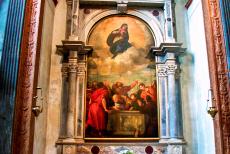
City of Verona: The Cappella Nichesola is one of three chapels of Verona Cathedral, the chapel houses the altarpiece the Assumption of the Virgin Mary, painted by Titian. The kneeling apostle to the left hand side represents the architect Michele Sanmicheli, one of the greatest architects of his time, he designed several buildings in the city of Verona and in the Venetian Republic.
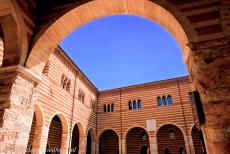
City of Verona: The courtyard of Palazzo della Ragione, the Palace of the Municipality of Verona, was built in the period 1193-1196. Over the centuries, the Palazzo della Ragione was the centre of political power of Verona. The Notaries' Chapel is the most beautiful room in the palace. The 15th century courtyard, the Cortile del Mercato Vecchio, served as a market place.
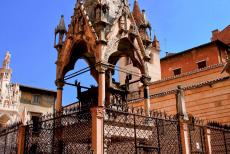
City of Verona: The Scaliger Arches with the tomb of Mastino II, a member of the Scaliger family. The Scaliger Arches are the monumental tombs of the Scaliger Lords of Verona. The tombs are surrounded by statues of the Scaliger Lords. The famous Scaliger Lords ruled Verona from 1260 until 1387 and for ten days in 1404.
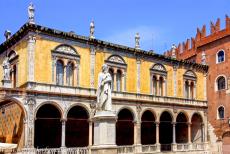
City of Verona: The Piazza dei Signori and the statue of Dante, facing the Palazzo del Capitano, once the home of the military commanders of the city of Verona. The yellow coloured Loggia del Consiglio was built in the 15th century, the roofline is decorated with statues of Roman people born in Verona such as Pliny the Elder and Vitruvius.
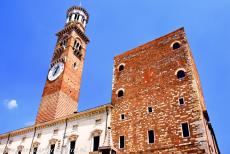
City of Verona: The Torre dei Lamberti is the city tower of Verona. The tower was built in 1172. The Torre dei Lamberti is 84 metres high, the clock was added in 1779. The tower was damaged by lightning in 1403 and was restored in the period 1448-1464. The red and white striped Torre dei Lamberti is the tower of the Palazzo della Ragione.
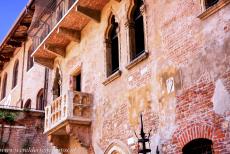
City of Verona: Juliet's balcony. Verona is the city of Romeo and Juliet. Although Romeo and Juliet were fictional persons, in Verona is a house said to be Juliet's House. Juliet's House is a place of pilgrimage for lovers. The Juliet's House dates from the 12th century, the balcony was added in the 1930s. Romeo's House is located close to Juliet's House. In contrast to the enormous crowds at Juliet's House, it was quiet at Romeo's House.
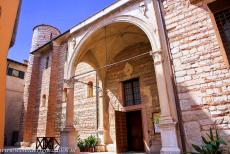
City of Verona: The porch of the San Lorenzo, the church was rebuilt after a heavy earthquake in 1117. The church represents the characteristic Romanesque style of the city of Verona, stripes of ochre tufa alternated with red brick. The towers situated on each side of the façade contain spiral staircases, leading up to the women's galleries. The San Lorenzo was restored after WWII.
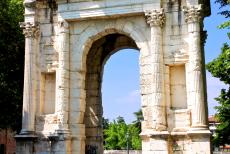
City of Verona: The Arco dei Gavi, the Gavi Arch, was erected in the 1st century in honour of the important Roman Gavi family, citizens of Verona. During the Middle Ages, it was used as one of the city gates. It was demolished by the troops of Napoleon in 1805. Under Mussolini, the Gavi Arch was rebuilt next to the Castelvecchio in 1932.
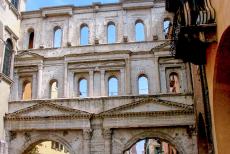
City of Verona: The façade of the Porta dei Borsari. The Porta dei Borsari is a 3rd century Roman city gate of Verona. At the Porta dei Borsari, traveling merchants had to pay taxes before leaving or entering the city. Only the façade of the gate remains. The city of Verona gained the status as a UNESCO World Heritage in 2000.
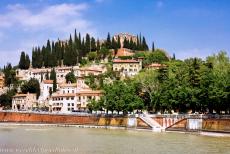
The city of Verona is situated in northern Italy in a loop of the Adige River near Lake Garda. The city of Verona was founded by the Romans, it was ruled by a number of occupants such as the Republic of Venice and Austria, it became part of Italy in 1866. The city of Verona was declared an UNESCO World Heritage because of its architecture from several historic periods.
